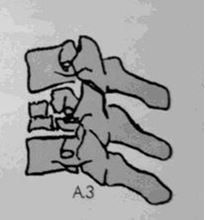Lateral Spinous Process Fracture
Spinal fractures are most often the result of falls, motor vehicle accidents, or sports injuries. Lateral process fractures may occasionally be associated with renal injury.
Figure. Fracture of right lateral spinal process or first lumbar vertebra

A 38 year-old male slips at home while rushing down hardwood stairs wearing only socks and falls hard onto the stairs injuring his back. He is having a lot of trouble walking because of right-sided low back pain that radiates up his back and down to his thigh when he tries to stand. He says he took two ibuprofen at home without relief. He denies any neck pain, head injury or other injuries or complaints. He takes no regular medication and has no prior medical conditions. He has a friend at the bedside who drove him to the ED.
On physical examination vital signs are all normal except for his blood pressure, which is elevated at 147/81 mm Hg, most likely a result of pain. His head and neck are non-tender and atraumatic. The upper back is non-tender, however he is tender in the lower back, more so on the right side with a slight abrasion. His neurovascular examination is intact.
You order spinal films. The lateral view is normal. The AP view is shown at right.
Do you see anything wrong? (Click on image to enlarge and look carefully)
Answer: Lateral spinous process fracture
There is a fracture of the right lateral spinal process or the first lumbar vertebra. If you missed it, don’t feel badly-so did the radiologist. Since there was no compression fracture and no gross hematuria, no further testing was indicated. The patient received crutches to aid in ambulation and a prescription for pain medicine. On follow-up he was doing much better.
Discussion: Lumbar Spinal Fractures
Spinal fractures are most often caused by falls, motor vehicle accidents and sports injuries. Lumbar spinal fractures can either be unstable or stable. Unstable fractures are more severe, typically involving two out of the three spinal columns (anterior, middle, and posterior), and have a significant risk of leading to spinal cord injury. Unstable lumbar fractures are characterized by loss of height greater than 50%; translation more than 2mm, kyphosis greater than 20°, or dislocations. The most common type of unstable fracture is the burst fracture.
Stable fractures are extremely unlikely to be associated with spinal cord injury. The most common of these is a wedge compression fracture where there is less than 50% loss of anterior height. These most commonly occur in patients with osteoporosis or significant trauma and most commonly affect the lower thoracic and upper lumbar vertebrae. Lateral and spinous process fractures are less common and typically are stable but flexion-extension views should be obtained to rule out concomitant ligamentous instability.
Lateral process fractures like the one in this case may occasionally be associated with renal injury. If a screening urinalysis shows gross hematuria, pursue further testing to image the kidney. If there is only microscopic hematuria, no further renal testing is necessary. See the Table for more details.
Simple Fractures: